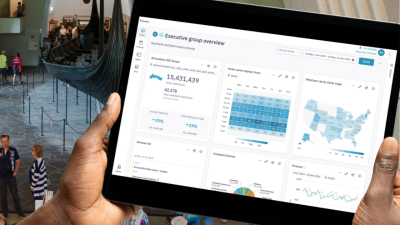
As I untangle the strange economics that shape our field, I’ve written several posts exploring the causes and consequences of the generally low salaries attached to museum work. In The Museum Sacrifice Measure I asked how poor people are willing to be in order to work in a museum; in What is the Fair Market Value of a Museum Job I explore the dysfunctions that arise from people feeling trapped in their current professions.
Today I’m sharing some thoughts about a third factor shaping wages in our sector—the fact that so many people are willing and eager to do this work for free.
In fact, the majority of people working in museums are volunteers. The last national financial survey AAM conducted (published as 2009 Museum Financial Information) reported a median figure of about 6 volunteers for every paid staff member for museums overall. That ratio soared to 18:1 in museums with budgets under $250,000, but even in the largest museums, volunteers generally outnumber paid FT staff two to one.
As a museum person, this figure surprises me not at all. I started out (at age 12) as a museum volunteer. The first museum where I held a paid job—a small children’s museum-cum-nature center—couldn’t have existed without volunteers. And Cincinnati Museum Center (my last museum job before defecting to the association world) had a whole army of volunteers, with a full-time staff person dedicated to providing them with training and support.
Because museum volunteers are ubiquitous, it took me a long time to realize that free labor has its problematic aspects. For one thing, it’s ripe for abuse. For example, the Fair Labor Standards Act is crafted to prevent employers from pressuring staff to “volunteer” their time (in lieu of counting these as work hours, triggering time-and-a-half pay). The need to guard against this kind of exploitation put the Department of Labor in the position of defining what constitutes legitimate volunteerism, to wit: “Individuals who volunteer or donate their services, usually on a part-time basis, for public service, religious or humanitarian objectives, not as employees and without contemplation of pay, are not considered employees of the religious, charitable or similar non-profit organizations that receive their service.” Such activities are characterized as “ordinary volunteerism,” and DOL considers a number of factors when called upon to determine whether a given set of activities are “ordinary,” including “whether full time employees are displaced.”
Except except except. As someone who has worked in museums of various types and sizes, and combed through the financial statements, org charts and policies of literally hundreds of museums of all types, I’d be unable to hazard an opinion on whether any given volunteer, or set of volunteers, is “displacing” a full time, paid employee. Does the volunteer director of a tiny, all-volunteer historic house museum “displace” a (theoretical) paid director the governing authority would otherwise have to fund? Would a large museum employ more (paid) interpreters if they didn’t have a dedicated and passionate core of docents?
I worked in a natural history museum that relied on volunteer (aka “adjunct”) curators and collections managers to care for collections that would otherwise wither from neglect. I know for a fact we weren’t in a financial position to create paid positions to do that work. Does that mean we should have deaccessioned the collections, rather than maintain them with volunteer labor for the present, with the potential for paid staff in the future?
As I talk to museum people about labor and wages, I often sense an undercurrent of resentment about volunteers. Some people come right out and say that museums should hire a “real” (i.e., paid) staff person rather than allowing someone to do the work for free. This troubles me in part because I’m pretty certain that museums can’t afford to support six times the people they currently employ (see ratios from the MFI, above). And I would hate for us to scale back our work to only that we can accomplish through paid staff.
But this also bothers me for a much more fundamental reason: volunteerism isn’t just a stop gap measure; it is a good in and of itself. The US is unusual among nations in the size and strength of its third sector—the nonprofits that complement the work of private business and government. I believe (from my admittedly imperfect knowledge of political and economic history) that nonprofits are embedded so deeply in US culture because from our inception we valued nonprofit associations as a forum for civic participation. When Alexis de Tocqueville visited the United States in the early 1800s, he noted that our new nation was strengthened by public participation in a wide range of civic associations, including clubs, churches, community groups and nonprofits of all types. Volunteering isn’t just a way for nonprofits to make their dollars stretch as far as possible. One of the benefits nonprofits provide to society is the opportunity to volunteer.
Volunteers are a necessary and desirable part of the museum workforce. They are a distinct class of people who benefit from museums in deep and meaningful ways. And they expand our ability to do good work that reaches others. With due respect to DoL, I think it’s impossible to draw a bright line between work that is enhanced by volunteers and work that is displaced by unpaid staff. And I think it’s inevitable that museum salaries are influenced by free labor. That makes the job of setting fair and equitable wages more difficult, but not impossible. And so the conversation continues…
Skip over related stories to continue reading article








The ubiquity of volunteering pretty much makes volunteering (or interning) mandatory – I can't count how many postings I've seen that want 5-8 years in a Registrar's office to be Assistant Registrar. Makes it practically impossible to break in directly out of even grad school.
There's also the consideration of volunteers as their own constituent audience for any museum. While I, too, have a lot of ambivalence about paid/unpaid labor in the museum sector, in almost all the places I've worked, the people who love an institution so much they're willing to volunteer their time are some of the most ardent museum fans. Yes, they're providing their time and expertise. They're also members of a museum's community who deserve appreciation.
Thank you for your comment, Corinne. I want to be clear I am not writing about internships, which are a separate issue that my colleague Nicole is covering in great depth. I am not sure that the ubiquity of volunteering causes museums to expect experience in applicants for job positions. It may enable the practice of museums requiring prior experience, but museums can consciously choose NOT to privilege unpaid experience in structuring their job searches.
I agree, Rachel, museum volunteers are often museums' most devoted supporters. They occupy a special and valued place in our universe!
An interesting place to move from here is a more nuanced discussion over what volunteers are getting out of the experience and for the sake of labor force equity, it's a mistake if what your volunteers are getting is "workplace experience".
The way I see it, volunteerism is an equation. Volunteers are inputting unpaid labor in exchange for something that benefits the volunteer, and this something is worth equal the worth in wages (or in costs of getting to the volunteer position) to the volunteer. This "something" that the volunteer is getting depends entirely on the program- in the youth volunteer program I used to run, there was an academic component to the volunteering in service learning hours, plus we offered services to the kids such as helping them with their college applications, giving them access to staff for informational interviews as they weighed career choices, etc. But to create a volunteer program that fulfills this takes labor from the museum, and that labor should be equivalent to the labor that you're getting from volunteers.
I don't think we can talk about the history of volunteerism in America, especially in the museum and (especially) historic preservation fields without acknowledging the troubling legacy of privilege in regards to volunteerism. The first historic houses in the US and the first attempts to preserve heritage were undertaken those by the time and education to affect society (read: rich white ladies) and that has had a profound effect on who sees themselves being welcomed into a volunteer corps, who serves on a board of directors, and what stories our institutions tell, and that's a legacy we're still struggling through today. There's no way around that and that's worth a whole post exploring.
Finally, I think another follow up to examine is people who are volunteering as a way to get their foot in the door in the museum field. I think there are a few sides to this; on one hand, this can knock out people who can't afford to volunteer or don't see themselves as volunteers because they don't fit the portrait of who a museum volunteer usually is. On the other hand, since museum work is a profession that not a lot of people think about and not a lot of people know the details about, it's important for emerging museum professionals to actually know a bit about the profession, especially if they're considering making the expensive commitment to the field in the form of a graduate degree. So until we find a better way for people to learn more about the field before making a commitment to it, I think volunteerism is an important step in career exploration. That being said, someone can probably volunteer for a short period to figure out if this is their calling or not, and volunteer coordinators should be open to those types of volunteers if they want to expand the field….
The piece highlights a growing trend in the museum sector, to use volunteers in lieu of paid staff. This goes beyond the 'work experience' situation and it is not because volunteers are not professional but it is a catch 22 situation: volunteers want to do the work, its free, so the museum sees no point in paying someone to do the same work; so the cycle continues.
The cycle does contribute to the depressing of salaries in the sector, though it is one of many factors, including the economic climate and the idea that staff are a 'cost', not a 'benefit' to an organization. Personally, coming from a different sector into museum work, I am still gobsmacked that many museum positions with low salaries 'require' a Masters and more often a PhD.
Volunteer hours contributed may be a better measure than number of volunteers. At my institution, for example, we have 200 volunteers to 34 full-time staff: about a 6:1 ratio. But this can be a little misleading. Those 200 volunteers contribute on average about 30,000 hours, or equivalent to about 15 full time positions–more like a 1:2 ratio of volunteer hours to staff hours. I make no claim that this is typical, but simply a better way to measure.
In the rural area where my museum is located, we see mostly retirees in our volunteer force, and we regard them, as Rachel suggested above, as an important constituent group–people to be cultivated. We have our volunteers only because they see the experience as worth their while and receive some intangible benefit from it.
The question about whether our volunteers are doing jobs that we would otherwise hire for is a good one, and there are some functions where this is the case. When we added a vehicle for visitor tours, we debated staffing up vs. a volunteer operation. We opted for volunteers and did most of the checks we would for employees–verified licenses, conducted random drug tests, etc. Today this is among our most popular volunteer assignments. Undoubtedly, if we turned it over to hired staff, we would have some pretty unhappy volunteers.
We use staff, in many cases, to do the less desirable assignments–routine maintenance, for example–and find volunteers eagerly coveting certain others–leading public tours, anything involving carpentry, festival staffing, cataloging, and more.
Our nonprofit business model dictates the extensive use of volunteers. As earned income provides slightly less than half of the institution's support, donor revenues are large piece of the pie. And many of our supporters are more able and willing to donate their labor than to give the funds it would require to accomplish the institution's work with paid staff.
I would note that in some respects, volunteering is no different from internships. The universal advice given by museum professionals to recent grads who've had temporary jobs and internships but can't get hired is to volunteer in order to make contacts, continue getting experience, and show willing. I don't really understand why the museum world has become so affronted by unpaid internships but treats volunteering as "paying your dues" and a logical way to get a foot in the door. At the same time, if museums stop counting unpaid experience in job searches, the field will become even more ridiculously difficult to get started in.
I'm a big fan of the volunteers who help out in all the positions most museums would never be able to pay for – assembling bulk mailings, manning the front door, helping to set up for special events – but I have to admit to always being leery of the idea of volunteer directors or curators. Especially curators. I've worked in a few historic houses and I've seen the damage that can be done in a collection when the person registering/accepting/storing donations doesn't have the sort of training that's now mandatory for those positions when paid. Poor documentation, improper storage, etc. In some cases, benign neglect might be better. In others, well … it's a really difficult question.
For what it's worth, there *are* specific examples of paid staff being replaced by volunteers (http://articles.latimes.com/2012/may/01/entertainment/la-et-getty-cuts-20120501 and http://www.bbc.com/news/uk-england-hampshire-11783563 are two examples that made the news).
Anecdotally, there was that time I ran into a former coworker on the (DC) Metro and asked how things were at XYZ Museum. She replied that she was no longer there – they cut most of the positions in the department we were in, and she spent her last day on the job training a volunteer to do all the job duties she had been, up until that day, getting paid to do.